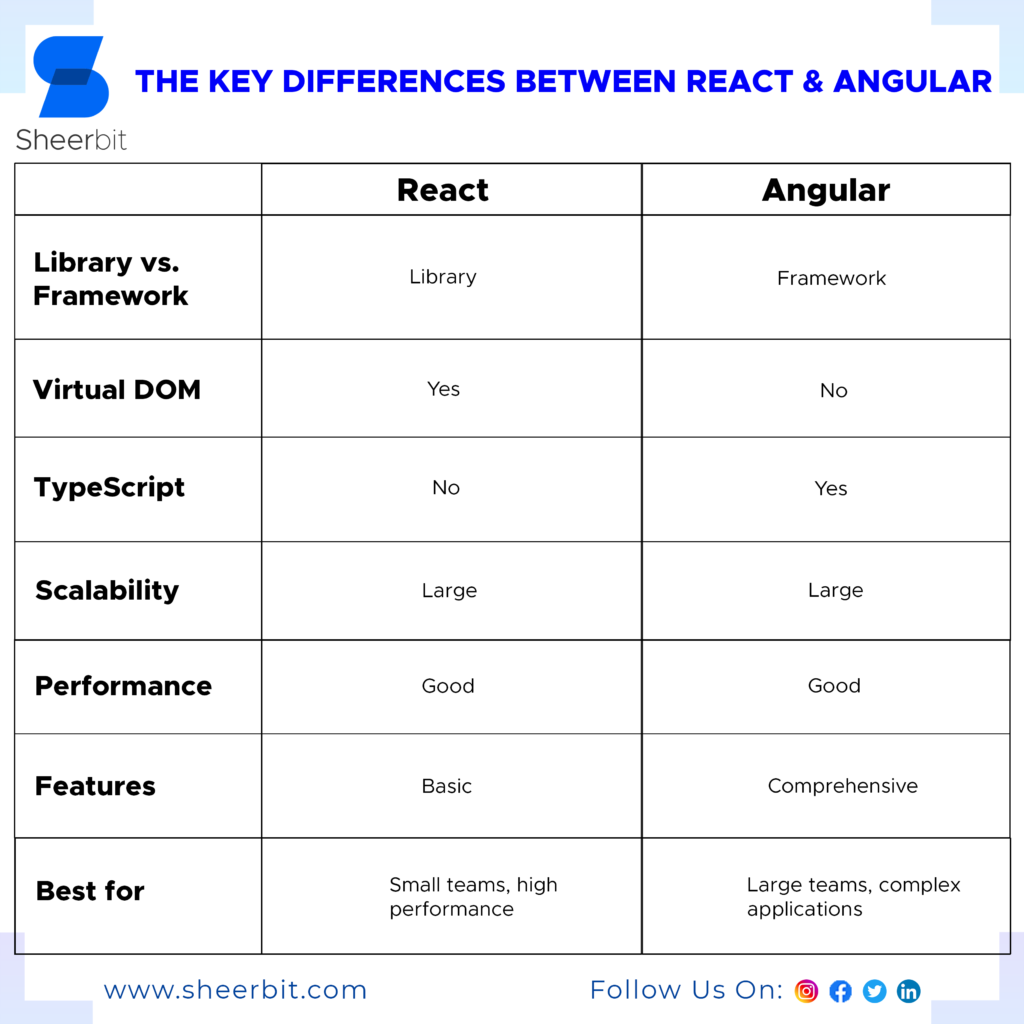React and Angular are two of the most popular JavaScript frameworks for building front-end applications. Both frameworks have strengths and weaknesses, so it can be difficult to decide which is right for your project.

1. Overview of React and Angular:
React:
React, developed by Facebook, is a JavaScript library that focuses on building user interfaces. It follows a component-based approach, where the UI is broken down into reusable components. React employs a virtual DOM, allowing for efficient rendering and updating of components. It has a vast ecosystem with numerous libraries and community support.
Angular:
Angular, developed and maintained by Google, is a comprehensive TypeScript-based framework. It provides a complete solution for building dynamic web applications. Angular follows a declarative approach and relies on two-way data binding. It offers features like dependency injection, routing, and form handling, making it a full-fledged framework.
2. Learning Curve and Development Experience:
React:
React has a gentle learning curve, making it easier for developers to get started. It has a straightforward syntax and a minimalistic approach, which allows developers to focus on building UI components. React’s virtual DOM enables efficient rendering, resulting in better performance. However, React’s flexibility can sometimes lead to decision fatigue when choosing between different libraries and tools.
Angular:
Angular has a steeper learning curve compared to React, mainly due to its extensive feature set and complex concepts. It requires a solid understanding of TypeScript and Angular-specific concepts like decorators and modules. Once mastered, Angular offers a structured development experience, with built-in solutions for common challenges. The Angular CLI (Command Line Interface) provides powerful tools for scaffolding and managing projects.
3. Performance:
React:
React’s virtual DOM and efficient diffing algorithm contribute to its excellent performance. It updates only the necessary components, minimizing the number of DOM manipulations. React’s lightweight nature allows for faster loading times and smooth user interactions. However, it may suffer performance issues when dealing with larger and more complex applications.
Angular:
Angular’s performance has significantly improved over the years. It uses its change detection mechanism to track component updates and optimize rendering. Angular’s ahead-of-time (AOT) compilation reduces bundle sizes and improves load times. However, Angular’s extensive feature set and two-way data binding can sometimes impact performance in larger applications.
4. Community and Ecosystem:
React:
React boasts a vast and active community, which has resulted in an extensive ecosystem of libraries, tools, and resources. React’s popularity ensures continuous development and innovation, with regular updates and improvements. The React ecosystem offers solutions for state management (Redux, MobX), routing (React Router), and UI components (Material-UI, Ant Design), among others.
Angular:
Angular has a strong community backing, with regular updates and long-term support from Google. Its ecosystem includes a wide range of libraries, such as Angular Material for UI components and NgRx for state management. However, the Angular ecosystem may not be as vast as React’s, which can sometimes lead to fewer options for specific requirements.
5. Scalability and Maintainability:
React:
React’s component-based architecture makes it highly scalable and maintainable. It allows for the reusability of components, making it easier to manage and extend the application. React’s one-way data flow ensures predictable and manageable state management. However, as the application grows in complexity, managing state across components can become challenging without proper architectural patterns or external libraries.
Angular:
Angular’s opinionated structure promotes scalability and maintainability. Its built-in features, such as dependency injection and hierarchical component structure, make it easier to manage large-scale applications. Angular’s two-way data binding simplifies state management, especially for forms and real-time updates. However, the learning curve and adherence to Angular-specific patterns might require additional effort for smaller projects.
We will compare React and Angular on several factors, including popularity, performance, learning curve, and community support. We will also provide some tips for choosing the right framework for your project.
Popularity
React is more popular than Angular, according to a recent survey by Stack Overflow. In the survey, React was ranked as the most popular JavaScript framework, with Angular ranking in fourth place.
Performance
React is generally considered to be faster than Angular. This is because React uses a virtual DOM, which allows it to update the DOM more efficiently.
Learning Curve
React has a steeper learning curve than Angular. This is because React is a more complex framework. However, there are many resources available to help you learn React, such as online tutorials and books.
Community Support
Both React and Angular have large and active communities. This means that many people can help you if you get stuck while developing your application.
Tips for Choosing the Right Framework
If you are new to JavaScript frameworks, Angular may be a better choice. Angular is a more comprehensive framework, and it has a lower learning curve.
If you are experienced with JavaScript and looking for a fast and efficient framework, React may be a better choice for you. React is a more lightweight framework, and it is known for its performance.
The best way to choose between React and Angular is to consider your specific project requirements. If you need a framework that is fast and easy to learn, React is a good choice. If you need a framework that has a lot of features and is well-suited for large teams, Angular is a good choice.
Conclusion
React and Angular are both powerful JavaScript frameworks that can be used to build great front-end applications. The best way to choose the right framework for your project is to consider your specific needs and requirements.





